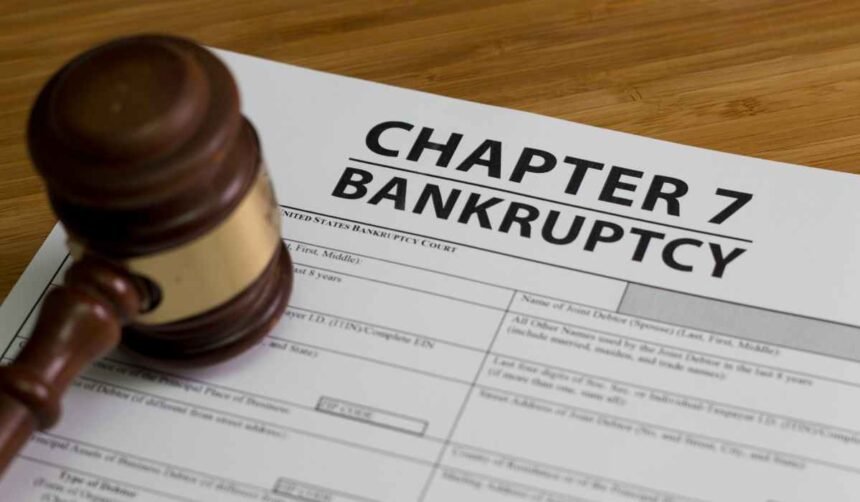Individuals and corporations can have a financial new start by filing for bankruptcy under Chapter 7 of the United States Bankruptcy Code. This process involves liquidating non-exempt assets to pay off debts.
A lifeline for people who are drowning in debt and facing financial catastrophe, bankruptcy can be a hard and emotionally fraught decision.
This tutorial will take you by the hand and show you how to file for Chapter 7 bankruptcy, as well as explain its benefits, drawbacks, eligibility requirements, and alternatives.
Understanding Chapter 7 Bankruptcy
Among the various types of bankruptcy available in the United States, Chapter 7 bankruptcy, sometimes known as “liquidation bankruptcy” or “straight bankruptcy,” is one of the most frequently used.
It’s meant to help people and some businesses get a fresh start financially by letting them liquidate non-exempt assets to pay off their unsecured debts like credit cards, medical bills, and personal loans.
Chapter 7 bankruptcy seeks to completely discharge debt, as opposed to Chapter 13 bankruptcy, which incorporates a repayment plan.
Step 1: Determine Eligibility
Check your eligibility for Chapter 7 bankruptcy before moving forward with the file. Income and financial stability are major considerations in determining eligibility.
Means testing was implemented to determine eligibility after 2005’s Bankruptcy Abuse Prevention and Consumer Protection Act (BAPCPA). The means test takes into account your income in relation to the state median as well as your ability to pay back loans.
In most cases, Chapter 7 is an option if your yearly income is below the state median for a family of your size. Even if your salary is higher than the average, you may still qualify after a thorough review of your finances.
Step 2: Credit Counseling
To qualify for Chapter 7 bankruptcy, you must first take part in credit counseling with a government-recognized organization.
This course will help you evaluate your current financial standing, research viable bankruptcy alternatives, and introduce you to practical budgeting and money management techniques.
It takes around an hour to finish the course, which may be taken either online or over the phone.
You must have a certificate of completion from a credit counseling school in order to file for bankruptcy.
Related: How Much Does It Cost to File Bankruptcy?
Step 3: Prepare and File Bankruptcy Petition
After you’ve established your bankruptcy eligibility and finished any necessary credit counseling, you can move forward with filing your petition. The bankruptcy petition is a lengthy legal document in which you lay out your whole financial condition, from your income and expenses to your assets and obligations and even your most recent financial activities.
You will need to gather the following documents and information for your bankruptcy petition:
- A list of all your creditors and the amount of debt you owe them.
- A list of all your assets, including real estate, vehicles, bank accounts, and personal property.
- A detailed breakdown of your monthly income and expenses.
- Tax returns for the past two years.
- Bank statements for the past six months.
- Documentation of any major financial transactions or transfers in the past two years.
Form B1, the official bankruptcy petition, and its accompanying schedules contain further facts about your financial status and must be filled out in detail before filing for bankruptcy.
Step 4: Filing the Bankruptcy Petition
The bankruptcy court in your area is where you’ll submit your Chapter 7 petition. The filing fee is usually several hundred dollars but might be more or less. The court may provide a fee waiver or permit payment in installments if the filing fee is prohibitive.
When you file for bankruptcy, the court will immediately issue an automatic stay, which prevents creditors from taking any further collection action (including filing suit, garnishing wages, or calling you). Creditor harassment is put on hold immediately as a result of this stay.
Step 5: The Role of the Bankruptcy Trustee
When you file for Chapter 7 bankruptcy, a trustee will be appointed to oversee your financial affairs. The bankruptcy trustee’s job is to oversee the liquidation of your nonexempt assets and the distribution of the proceeds to your creditors.
At the 341 meeting of creditors, the trustee will examine your financial records and may ask you questions about your financial situation. Usually, this conference takes place 30–45 days after your petition has been submitted.
In theory, your creditors could show up to this meeting and grill you about your financial woes, but in practice, they probably won’t.
Step 6: The Liquidation Process
Your nonexempt property may be liquidated in a Chapter 7 bankruptcy to satisfy your debts. Many Chapter 7 bankruptcy filers, however, find that they are able to keep all or nearly all of their property by using exemptions.
Exemptions are legal rules that allow you to keep certain assets, such your home, car, and necessities, up to a specified value.
Some states let you pick between state and federal bankruptcy exemptions, but others don’t. A bankruptcy attorney can help you figure out which exemptions apply to your case and how to best safeguard your assets.
Step 7: Discharge of Debts
The fundamental objective of Chapter 7 bankruptcy is to have some or all of one’s debts forgiven. A discharge is a judicial order that cancels your legal responsibility to pay off most types of unsecured debt.
Credit card debt, medical bills, and personal loans are typical instances of unsecured debt that can be written off in bankruptcy.
However, some debts are not dischargeable in Chapter 7 bankruptcy, including:
- Student loans (unless you can prove undue hardship).
- Child support and alimony.
- Certain tax debts.
- Court-ordered restitution or fines.
- Debts incurred through fraud or malicious intent.
Step 8: Financial Management Course
After filing for bankruptcy, you must take a course in personal financial management from a government-recognized provider before your debts will be discharged. This class will teach you how to create a budget and manage your money so you don’t run into money problems in the future.
You must submit your completion certificate to the bankruptcy court when you have finished the course.
Step 9: Rebuilding Your Credit
The elimination of your dischargeable obligations in Chapter 7 bankruptcy can be a fresh start, but it will have a major negative effect on your credit score. If you’ve recently filed for bankruptcy, you may find it difficult to get credit for at least the next ten years.
However, it is possible to repair credit. Some things to think about are as follows:
- Make a plan for your money and stick to it so that you may handle your funds wisely.
- To begin building a solid credit history, you should apply for a secured credit card or a credit-builder loan.
- Utilities and rent should be paid on time to demonstrate fiscal responsibility.
- Keep an eye on your credit reports and correct any inaccuracies you find.
- Have faith that your credit history and score will gradually improve as time passes.
Chapter 7 Bankruptcy Advantages
Chapter 7 bankruptcy offers several advantages:
- Debt Discharge: Most unsecured debts are discharged, providing a fresh financial start.
- Automatic Stay: An automatic stay stops creditor harassment and collection efforts.
- Quick Process: Chapter 7 typically takes three to six months to complete.
- Exemptions: Many filers can protect their essential assets through exemptions.
- No Repayment Plan: Unlike Chapter 13, there’s no repayment plan to follow.
Chapter 7 Bankruptcy Disadvantages
While Chapter 7 offers significant benefits, it also has its drawbacks:
- Impact on Credit: A Chapter 7 bankruptcy remains on your credit report for ten years.
- Asset Liquidation: Non-exempt assets may be sold to pay creditors.
- Eligibility Criteria: Not everyone qualifies for Chapter 7 bankruptcy due to income restrictions.
- Non-Dischargeable Debts: Some debts cannot be discharged.
- Public Record: Your bankruptcy filing becomes a public record.
Alternatives to Chapter 7 Bankruptcy
Before filing for Chapter 7 bankruptcy, it’s essential to explore alternative debt relief options:
Chapter 13 Bankruptcy: Chapter 13 may be an option if you are able to commit to a repayment plan and have a steady source of income.
Debt Consolidation: Consolidating many outstanding loans into one simpler one.
Debt Settlement: Negotiating with creditors to settle debts for less than the full amount.
Credit Counseling: Seeking advice from a credit counseling agency to create a debt repayment plan.
Budgeting and Financial Counseling: Learning effective budgeting and financial management skills.


